1. What is a Bank Angle Calculator?
Definition: This calculator determines the speed, friction coefficient, or banking angle for a vehicle navigating a banked turn, accounting for turn radius, speed, and friction.
Purpose: It is used in physics, aviation, and automotive engineering to ensure safe and efficient turns on banked surfaces, such as racetracks or aircraft maneuvers.
2. How Does the Calculator Work?
The calculator operates in three modes:
Speed (v) Mode:
\[
v = \sqrt{r g \left( \frac{\tan \theta + \mu}{1 - \mu \tan \theta} \right)}
\]
Friction Coefficient (μ) Mode:
\[
\mu = \frac{\frac{v^2}{r g} - \tan \theta}{\tan \theta \cdot \frac{v^2}{r g} + 1}
\]
Banking Angle (θ) Mode:
\[
\theta = \arctan\left(\frac{v^2 - r \cdot g \cdot \mu}{r \cdot g + v^2 \cdot \mu}\right)
\]
Where:
- \(r\): Turn radius (m)
- \(g\): Gravitational acceleration (9.80665 m/s²)
- \(\theta\): Banking angle (radians)
- \(\mu\): Friction coefficient (unitless)
- \(v\): Speed (m/s)
Unit Conversions:
- Turn Radius: m, ft (1 ft = 0.3048 m), km (1 km = 1000 m), mi (1 mi = 1609.344 m)
- Banking Angle: degrees, radians (1 degree = \( \pi/180 \) radians)
- Speed: m/s, km/h (1 km/h = 0.277778 m/s), mph (1 mph = 0.44704 m/s), kn (1 kn = 0.514444 m/s)
Steps:
- Select the calculation mode (Speed, Friction Coefficient, or Banking Angle)
- Enter the turn radius (r), selecting the unit (m, ft, km, mi)
- For Speed mode, enter the banking angle (θ) and friction coefficient (μ)
- For Friction mode, enter the banking angle (θ) and speed (v)
- For Banking Angle mode, enter the speed (v) and friction coefficient (μ)
- Convert inputs to SI units (m, radians, m/s)
- Calculate the result using the appropriate formula
- For Speed or Banking Angle modes, select the desired unit for the result and view the converted value
3. Importance of Bank Angle Calculation
Calculating bank angle parameters is crucial for:
- Safety: Ensuring vehicles or aircraft can navigate turns without slipping.
- Design: Optimizing road or track banking angles for specific speeds.
- Performance: Determining the required friction, speed, or banking angle for efficient turns.
4. Using the Calculator
Examples:
- Example 1 (Speed Mode): For a car on a racetrack with turn radius \( r = 100 \, \text{m} \), banking angle \( \theta = 15^\circ \), friction coefficient \( \mu = 0.7 \), and gravitational acceleration \( g = 9.80665 \, \text{m/s}^2 \):
- Banking angle: \( 15^\circ = 15 \cdot \frac{\pi}{180} \approx 0.2618 \, \text{radians} \)
- Speed: \( v = \sqrt{100 \cdot 9.80665 \cdot \left( \frac{\tan 0.2618 + 0.7}{1 - 0.7 \cdot \tan 0.2618} \right)} \approx \sqrt{980.665 \cdot \frac{0.9679}{0.8125}} \approx \sqrt{1168.331} \approx 34.181 \, \text{m/s} \)
- In mph: \( 34.181 \cdot 2.23694 \approx 76.465 \, \text{mph} \)
- Example 2 (Friction Mode): For an aircraft with turn radius \( r = 0.621 \, \text{mi} \), banking angle \( \theta = 0.349 \, \text{rads} \), speed \( v = 200 \, \text{kn} \), and gravitational acceleration \( g = 9.80665 \, \text{m/s}^2 \):
- Turn radius: \( 0.621 \cdot 1609.344 = 1000 \, \text{m} \)
- Speed: \( 200 \cdot 0.514444 = 102.889 \, \text{m/s} \)
- Term: \( \frac{v^2}{r g} = \frac{102.889^2}{1000 \cdot 9.80665} \approx 1.0795 \)
- Friction coefficient: \( \mu = \frac{1.0795 - \tan 0.349}{\tan 0.349 \cdot 1.0795 + 1} \approx \frac{1.0795 - 0.3646}{0.3646 \cdot 1.0795 + 1} \approx 0.512 \)
- Example 3 (Banking Angle Mode): For a vehicle with turn radius \( r = 50 \, \text{m} \), speed \( v = 20 \, \text{m/s} \), friction coefficient \( \mu = 0.3 \), and gravitational acceleration \( g = 9.80665 \, \text{m/s}^2 \):
- Numerator: \( v^2 - r \cdot g \cdot \mu = 20^2 - 50 \cdot 9.80665 \cdot 0.3 = 400 - 147.09975 = 252.90025 \)
- Denominator: \( r \cdot g + v^2 \cdot \mu = 50 \cdot 9.80665 + 20^2 \cdot 0.3 = 490.3325 + 120 = 610.3325 \)
- Banking angle: \( \theta = \arctan\left(\frac{252.90025}{610.3325}\right) \approx \arctan(0.4145) \approx 0.394 \, \text{radians} \)
- In degrees: \( 0.394 \cdot \frac{180}{\pi} \approx 22.573^\circ \)
5. Frequently Asked Questions (FAQ)
Q: What is a banked turn?
A: A banked turn is an inclined surface that allows vehicles or aircraft to navigate turns at higher speeds by providing a centripetal force through the banking angle and friction.
Q: Why is friction coefficient important?
A: The friction coefficient determines the grip between the vehicle and the surface, affecting the maximum safe speed or required banking angle on a banked turn.
Q: How does banking angle affect speed?
A: A steeper banking angle (\(\theta\)) increases the centripetal force, allowing higher speeds without slipping, as seen in the speed formula.
 Home
Home
 Back
Back
